 Don Birnam, a wannabe novelist, is sitting in Nat’s Bar, his local, on a Thursday afternoon getting drunk on the ten dollars he’s stolen from the sugar bowl in which his brother leaves some money to pay the cleaning lady.
Don Birnam, a wannabe novelist, is sitting in Nat’s Bar, his local, on a Thursday afternoon getting drunk on the ten dollars he’s stolen from the sugar bowl in which his brother leaves some money to pay the cleaning lady.
Birnam is trying to get the proprietor of the bar, Nat ,to join him in a drink. He knows the high he is seeking is “a viscious circle”.
“But let me have my little vicious circle,” he tells Nat who tries to wipe away the imprint of whiskey left by his customer’s shot glass on the counter. “The circle is the perfect geometric figure,” this Fool for drink explains. “No end, no beginning…” A perfectly intoxicated nought.
DON: Come on, Nat. One little jigger of dreams.
NAT: Nope.
DON: You don’t approve of drinking?
NAT: Not the way you drink.
DON: It shrinks my liver, doesn’t it, Nat? It pickles my kidneys. Yes. But what does it do to my mind? It tosses the sandbags overboard so the balloon can soar. Suddenly I’m above the ordinary. I’m competent, supremely competent. I’m walking a tightrope over Niagara Falls. I’m one of the great ones. I’m Michelangelo moulding the beard of Moses. I’m Van Gogh, painting pure sunlight. I’m Horowitz playing the Emperor Concerto. I’m John Barrymore before the movies got him by the throat. I’m a holdup man. I’m Jesse James and his two brothers, all three of them. I’m W. Shakespeare. And out there it’s not Third Avenue any longer. It’s the Nile. The Nile, Nat, and down it moves the barge of Cleopatra. Listen…
And we do listen as he begins to quote from Antony and Cleopatra, the language itself intoxicating:
Purple the sails, and so perfumed that
The winds were lovesick with them; the oars were silver,
Which to the tune of flutes kept stroke, and made
The water which they beat to follow faster,
As amorous of their strokes. For her own person,
It beggar’d all description.
We might take Don’s reasons for getting high as egotistical or narcissistic ones, that desire that we all carry within our primate souls, to be “above the ordinary”. Getting high within the primate hierarchy involves getting or going beyond our ordinariness, our nothingness in the grand scheme of things. We do this by elevating our natural as well as applied talents, hoping to become not only “competent”, but supremely competent in terms of how we live our lives, especially in the eyes of others, or of our own metacognitive, self-perceiving selves. The high Don refers to here also hints at what psychologists might call “peak experience” which Abraham Maslow, the creator of the term, describes as an “experimental” as well as deeply “experiential” state -nothing to do with thought- in which we find ourselves and the world to be “rare, exciting, oceanic, deeply moving, exhilarating, elevating; [an] experiences that generate an advanced form of perceiving reality, [which could also be described as] mystic and magical in their effect upon the experimenter.”
Who wouldn’t want a bit more of this in their lives? Is it any wonder then that we pursue our highs with such habitual ardour, even with a certain anarchic recklessness?
In this, the fifth and final of my Tarot Fool miniseries, this handful of tomfoolery that I am offering to you here before we move on to the next archetype, The Magician, I’d like to talk a little about getting high, and how it relates to the two fools we see in our Rider-Waite deck. These are: the Natural Fool or True Fool as I’m going to call them (aka the little white pooch we see a step ahead of the human animal by their side), as well as this more Fabricated Fool, this Misled or Misleading Fool, who for the most part happens to be You and Me.
I say you and me, because current estimates place the number of people using alcohol at around 2.4 billion (roughly one third of the Earth’s population). If you factor in all the other substances we employ to get high, including those more immaterial facilitators that help us to get there (music, art, country walks, as well as intoxicating ideas and culture conveyed in podcasts?) then this You and Me turns out to be pretty much everyone.
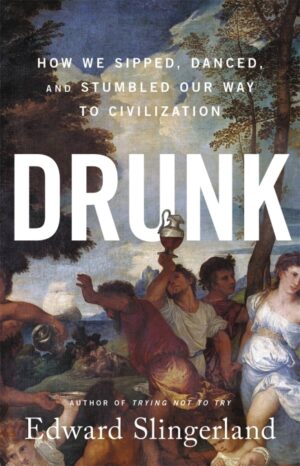 “Wherever you find people,” writes Edward Slingerland, whose book Drunk (published this year, 2021) “you will find ridiculous amounts of time, wealth, and effort dedicated to the sole purpose of getting high.”
“Wherever you find people,” writes Edward Slingerland, whose book Drunk (published this year, 2021) “you will find ridiculous amounts of time, wealth, and effort dedicated to the sole purpose of getting high.”
In ancient Sumer, it is estimated that the production of beer, a cornerstone of ritual and everyday life, sucked up almost half of overall grain production. When it comes to market economies, contemporary households around the world officially report spending on alcohol and cigarettes at least a third of what they spend on food; in some countries (Ireland, the Czech Republic) this rises to a half or more.
Slingerland’s main thesis for why this is, supported by some quite astounding anthropological and archeological data, is that early hominids who walked the earth up to 3 million years ago, faced a set of sociocultural challenges that their (now our) biology hadn’t fully prepared us for.
Finding shelter in caves rather than treetops, meant putting up with living conditions that were “crowded and full of strangers, non-relatives with whom we needed to somehow cooperate”. This required “both individual and collective creativity, intensive cooperation, a tolerance for strangers and crowds, and a degree of openness and trust that is entirely unmatched among our closest primate relatives.” Relative who are not especially known for being completely chilled and non-hierarchical it must be said.
Sarah Blaffer Hrdy, an anthropologist and primatologist, notes that if we were to pack a few hundred chimpanzees, one of our close primate cousins, into a cave, or its even more modern equivalent (an aeroplane) what you’d end up with on landing would be “a long metal tube full of blood and dismembered body parts”.
Humans are powerful in groups, so powerful that we have come to dominate and manipulate every other living group on this planet, precisely because we are weak as individuals. This makes us intensely eager to connect with one another. How intensely? Well, let’s just try and wrap our heads around the idea that at the moment, half a million podcasts like this one are being circulating around the culture, or stagnating in little puddles near the cow troughs. Or what about the186 million Twitter users telling each other on a daily basis what to think, read, or care about. Or the almost 3 billion human animals interacting on Facebook.
Perhaps this intense eagerness to connect stems partly from how utterly dependent we are on the group for survival. I didn’t source the electricity and bandwith that is allowing you to hear my words today, and you didn’t make those bluetooth headphones, or the mobile device you’re listening on, and yet we are both still of the belief that we are active agents, masters of our destiny (the I who made this, the you who listened to it), as opposed to interacting elements in a limitless transferral of energies we call life.
The main demands imposed upon us by the crowded cave, plane, lecture hall or shopping mall, to which we have all adapted to, can be summed up with what Slingerland calls the Three Cs: Creativity, Culture and Communication.
Getting high helps with all three of these. Here’s an example from my own therapy practice.
—
A client and I are working together one day on one of her burning questions. This particular question involves her relationship with cocaine. She has noticed that often when out on a Saturday night with friends and her boyfriend, there comes a point in the evening where some of her friends might be inclined to get some white powder into their nostrils, and even though she by this point has drunk enough and danced enough and chatted enough to call it a night, the enticement of the powdery white pick-me-up and the encouragement of those around her to partake in it, seems almost impossible to resist.
The only downside is her inability to sleep when she finally gets home and then dealing with the double-whammy hangover the following day. The burning question she now asks herself in our session is one we all pose to our selves at one point or another, which is to say: “Why do I struggle to stay on the path of healthy moderation with regard to food, drink, drugs, and all the other addictive stimulants in my life, when I know how important it is for my physical and mental well-being to find a kind of balance?”
I shuffle the deck, we’ve decided in this session to use some Tarot, and ask her to focus on her question whilst also starting to slowly deal the cards face down on the table in front of her. “Really focus now on your burning question,” I say. Put it out there as a kind of plea to the universe. Ask the question in whichever way feels most heartfelt, most earnest to you, in the hope for a response, which like a dream, or a poem, we might then be able to work with.”
After a while, she tells me to stop dealing and I turn over the next card. The Fool is looking up at both of us.
“Before we launch into any form of interpretation,” I say, “tell me the story of this card as it presents itself to you now in your imagination.”
“These two,” she says, pointing at the fool on his precipice and the little dog prancing at his side, “want to get high.”
“Why do they want to get high?” I ask.
She looks at me as if I am posing the most blitheringly obvious question ever asked:
“They want to get high because this one (pointing at the young fool, who is perhaps the same age as her) works all week long for a Chartered Surveyors company and only gets to play on the weekend when he can escape to the countryside, or to a gathering of friends. Getting high is wherever he can finally get away from all those PDF-filled screens, from all that bloody report-writing about damp and asbestos, and woodworm, and dry rot, and subsidence, and Japanese knotweed, or the threat of neighbouring trees. Getting high connects him to something more expansive than all of that stuff, all those building and things.”
“So getting high,” I say, “is an attempt to distance ourselves from what is experienced as the “grind” of daily life?”
“Yes.”
Why does the Fool struggle to find this kind of flow in their day-to-day, I ask.
“WhatsApp,” she replies. “WhatsApp and emails. Twitter, and Instagram, and Facebook. Zoom meetings, and needy boyfriends. City life.”
“What about the dog?”
“The dog doesn’t need anything to get high,” she tells me. “The dog is always high, high on life, high on Now. The dog is Eckhart Tolle with four legs and a cheerleading tail.”
“Why can’t the human animal get high on life too?” I wonder.
She shrugs, failing to find the words.
“Maybe,” I say, “it goes like this: when we are experiencing some form of pain or discomfort in our bodies or minds, our awareness of that state, that metacognitive awareness of our suffering selves, gets framed by our minds as a kind of problem, as something we need to fix. Getting high is seen by our problem-solving minds as one of the solutions to that problem. Getting high, however we attempt to do this, is, as the metaphor suggests, adopting a perspective from which we might look down on our pain and so shift, from this new vantage point of awareness, to a place where the perceived pain is less pressing, less present. And why should that not present itself to us as a very good solution to the struggle of existence?”
“Going home tired at 1 am,” she says, “feels like a cop-out, like getting halfway up the hill only to head back to base camp, which is why this one (she points again to the fool, to herself when she inhabits the archetype) needs to push on ahead, even though he knows the drop will be a painful one tomorrow morning.”
That’s right, I say, recognising the Fool in her and in myself.
At that moment, I think, clinging to that pleasurable, intoxicated awareness, elevated or detached in some way from the recognition of struggle or pain, is it any surprise that we don’t really want to spend too much time dwelling on the crumpled, crippled figure who has come back to earth with a painful jolt the day after. That part of us who pays for our foolishness, that future-now person, experiencing the painful after-effects of soaring so high, fuelled by drugs or booze or food or phones, whatever it is, only to come crashing down again, to feel ourselves at the place where we started from. Or worse.
“I get all that,” she says. “But I guess I wonder why he has to be up there?” What’s so bad about going only halfway up the mountain. What’s so bad about moderation?
“Yes, but if we have experienced that view from the peak,” I say, “why wouldn’t we be driven over and over again to go back? Nobody wants to feel themselves as passive bystanders to their suffering souls, or to their one shot at life, this shot at life, we call here-and-now. Is not a lot of what we do in the psyche an attempt to state-shift, from one way of experiencing the world to another; emotional regulation we might call it, when using all the culturally sanctioned means of access.
There seem to be two forces at work here. Something that is experienced as negative (painful) in the psyche, pushing us from below to climb higher and higher, as well as something, dare I say spiritual, freeing, joyful, beckoning us on from ahead. We might use words like fun or pleasurable, but these merge on an experiential level into one of our greatest aspirations as embodied psycho-spiritual beings: to attain transcendence of our sometimes leaden, all-too-material embodiment, and even more so our suffering minds. And in so doing, gain access to more of the numinous, the nondualistic, to something consummate, flawless, and unblemished within ourselves and our world.
Unfortunately the animal human world of work, family life, buying stuff, and watching the latest must-see TV series, doesn’t always induce these transcendent states we all desire. And sure there are other non-intoxicating ways to get there including extreme temperatures, starvation and fasting, sexual activity and orgasm, holotropic breathwork, sensory deprivation or overload, drumming and dancing, relaxation, meditation, hypnosis and biofeedback, these take work, and we primates would prefer to eat fruit and climb trees, so…maybe we all secretly find ways to access the numinous through the backdoor, whilst virtue-signalling whenever we do it via the gym or yoga mat.
Intoxicants may even have been core to our 12,000 year history which we now refer to as civilisation. Indeed, the world’s oldest recipe (part of a Sumerian myth) is for beer not bread. Take a selfish, often warring, small-group of hunter gatherers who by all accounts had a far more diversified number of food sources than we currently have, but who might choose to live a more settled, and protected existence, also in order to create the “medicine” (beer, wine, and other intoxicants) that are so helpful to them when it comes to putting up with all the other complicated people they’re having to interact with on a daily basis.This bottom-up explanation (sometimes called the “beer before bread” hypothesis) also works top-down.
“By causing humans to become, at least temporarily, more creative, cultural, and communal—to live like social insects, despite our [selfish, warring] ape nature—intoxicants provided the spark that allowed us to form truly large-scale groups, domesticate increasing numbers of plants and animals, accumulate new technologies, and thereby create the sprawling civilizations that have made us the dominant, as well as most destructive mega-fauna on this planet.”
Throw a bunch of rats into an overcrowded cage, and their physical as well as mental health will plummet. Even 12,000 years ago, villages in the Fertile Crescent contained 200 to 300 people, and already showed signs of private property, wealth inequality, and social stratification. Imagine the biopsychosocial strain on these animals (you and me), the effects this might have on our mental and physical health, unless we are able to find ways to deal with this often too-close proximity to others like us, who no matter how much we love and need them, also have the capacities, linguistic and otherwise, to drive us totally round the bend.
Maybe dodgy cocaine, with no idea of its provenance, might not be the answer here, but getting high on something, as well as someone, seems to be inextricably built into our human animal experience.
“By enhancing creativity, dampening stress, facilitating social contact, enhancing trust and bonding, forging group identity, and reinforcing social roles and hierarchy,” writes Edward Slingerland, ”intoxicants have played a crucial role in allowing hunting and gathering humans to enter into the hive life of agricultural villages, towns, and cities. This process has gradually scaled up the scope of human cooperation, eventually creating modern civilization as we know it.”
“If your goal is to maximize implementable cultural innovation,” Slingerland explains, “your ideal person would be someone with the body of an adult but, for a brief period, the mind of a child. Someone with downregulated cognitive control [through their prefrontal cortex], heightened openness to experience, and a mind prone to wander off in unpredictable directions. In other words, a drunk, stoned, or tripping adult. Societies have come to associate intoxication with creativity, communication, and cutlure because chemical intoxication has been a crucial and widely used technology to effect this transition from adult to mental childhood in a relatively controlled manner.”
 After this session on the pleasures and perils of coke, I take Mr Max for a walk in Stanmore. Mr Max as I sometimes call him, also Maxie-jacks, Maxie-Pax, and a whole host of other silly names, has been in my life for the last six years.
After this session on the pleasures and perils of coke, I take Mr Max for a walk in Stanmore. Mr Max as I sometimes call him, also Maxie-jacks, Maxie-Pax, and a whole host of other silly names, has been in my life for the last six years.
Max I would say is on the extrovert spectrum, so although he tolerates my company, he is happiest, and highest when our duo becomes a trio, or more. Max is often high, even deliriously high, emitting a noise that sounds a lot like an extended chuckle or a guffaw when he is in this state. And if you don’t believe that non-human animals can laugh, please watch the affective neuroscientist Jaak Panksepp on YouTube tickling rats in his lab, those rats sure seem to be getting high on tickles I would say. Max’s “laughter” is one of the indicators that he loves us human animals, or at the very least enjoys our company. And we undoubtedly love and are thrilled by being around him, which is a curious paradox when you consider the respect and consideration we pay to our pets whilst also eating all the other pets on the planet, but that’s just how it goes.
Max’s highs are not that dissimilar from how I get high. Walking on a path together through a natural setting is a good place to start, with Max trotting ahead, tail raised and bobbing from side to side like one of those tour guides in central London, leading their charges through a scrum of tourists.
Max also enjoys running, chase, and dancing, with or without music. I feel like I am now writing a dating profile for him, maybe I am. He is also enlivened by almost all balls and obsessed with squirrels.
My highs are more manipulated or fabricated psychic events. Such as the high that comes from being captured by a song, a book, a film or television documentary, an idea, or a conversation: anything really within the realm of symbolic transfer, galvanizing those uplifting energies of curiosity, pleasure, wonder, awe.
Perhaps it is language more than anything else I want to be high on. Even writing this sentence I am hoping to get high, and who knows something in its rhythm and flow might take me there. “I am not making a fool of myself / For you,” writes WS Graham in an almost admonitory tone in his poem called What is the language using us for. “What I am making,” he goes on to remind himself via us, his readers, is “a place for language in my life”:
Which I want to be a real place
Seeing I have to put up with it
Anyhow. What are Communication’s
Mistakes in the magic medium doing
To us? It matters only in
So far as we want to be telling
Each other alive about each other
Alive. I want to be able to speak
And sing and make my soul occur
In front of the best and be respected
For that and even be understood
By the ones I like who are dead.
I would like to speak in front
Of myself with all my ears alive
And find out what it is I want.
Being human animals though, we like to get high on all sorts of non-linguistic things, including Psychoactive substances like tea, coffee, sugar, alcohol in its various guises, and cannabis. Also delicious-tasting food, and sex, and pretty much anything else we can introduces to our various orifices and sensory organs. Watching planes taking off and landing, for some folk, gets them high. What does it for you?
A more florid word for this high is ecstasy. From the Greek ek-stasis, or literally “standing outside oneself.” A modern way of describing that metacognitive state is of course mindfulness, as in the famous Kabat Zinn definition of “paying attention, on purpose, in the present moment, non-judgementally, in the service of self-understanding and wisdom.”
In order to do this, one aspect of consciousness needs to separate from another, and in so doing, take a reading of the other part, as you the human animal listening to this, might stands outside the me speaking here, “ecstatically” seeing and hearing aspects of my communication that I might not even be aware of.
In placing these two words side by side, however, ecstasy (to my ears) sounds sensual, and corporeal, an adventure, an experiment in living, whereas mindfulness descriptors often strike my ear as if they were devised by an engineer or scientist delivering a powerpoint slide in a draughty function room about The Meaning of Life, or How To Get High. Perhaps if we were to meet the historical buddha, he might have something of that vibe about him, who knows.
That’s Uma Thurman’s 80 year old father, Robert Thurman who sounds pretty ecstatic I think you’d agree expostulating on the four noble truths, so perhaps they aren’t as square as they sometimes come across.
Maybe this is because in ecstasy, as opposed to mindfulness, the monitoring self, aka the Prefrontal Cortex (PFC) which plans and forecasts, as well as moderates certain forms of behaviour and speech mainly functions in the key of NO. Being a recent evolutionary development, PFC Plod, works as an inhibitor, or brake, on our wayward animality, a curb, a restraint, a deterrent on enthusiasm and ecstasy. Of course you want to have that second vegan cornetto from the four-pack pack you bought from the supermarket, well I do, and maybe even a third or fourth, but unless you’re high, your PFC will probably caution you against overdoing it.
Ecstasy pulls the plug on the nay-saying, parental-sounding PFC, so of course that’s why, we love the YES of Ecstasy, in the way that children and dogs love grandparents, or Daddy’s girlfriend who showers them with treats in a way that their more mindful self-protective begetters never do or did:
“Sobriety diminishes, discriminates, and says no,” writes William James in The Varieties of Religious Experience, “drunkenness expands, unites, and says yes. It is in fact the great exciter of the YES function in the human animal. It brings its votary from the chill periphery of things to the radiant core. It makes us for the moment one with truth.”
I love that line “it brings its votary from the chill periphery of things to the radiant core”. The votary being an often moral category, a monk or nun, adherent of a religion or cult. But in this phrase, I think James is expanding the category to include all of us. All who live in the chill peripheries of the mind with its concerns and gripes, its worries about this or that, who are brought even one step closer for even a brief period of time, to the radiant core of pure being. To ecstasy.
For me the animal who speaks through the fabrications of language, and for Max the animal who speaks through embodied gestures, the yes of that high, often appears to us as the very reason we might want to non-judgementally pay attention, on purpose, in and to the present moment at all!
I’ve always been strangely proud of the fact that I can give the Hungarian pronunciation for the following name, which when read as it is spelt, sounds something like: MI-HAY-LY CSICK-ZENT-MIHAL-YI.
But of course this is not how you pronounce the name , or so I am told, which in Hungarian sounds more like: MEE-HIGH, CHEEK SENT ME HIGH. When pronounced correctly, as you can hear, it is a name that has more HIGHs in it than a stoner film.
The only reason you would have to pronounce this Hungarian name correctly is if you wanted to talk about the concept of Flow, that ability we have to lose ourselves in a task, and in so doing achieve a state of well-being and focus which is not especially dissimilar to being high.
The fools energy is flow. Even the word flow tells you what it’s about. A gathering of forces as lips and teeth make an F and an L, which then gets pushed out of the mouth like a sleigh being pushed down a snowy hill.
Floow. Flooow. Floooooooooooow.
Flow captures that delicious ontology of being both here and not here, both doing and not doing. It is a deeply non-binary state, and because it is so embodied, language struggles to get a hold on it.
Instead listen to Jacob Collier playing on a tiny acoustic bass, that inimitable melodic line for Stevie Wonder’s Boogie Down Reggae Woman, watch the video of him playing it on YouTube too, if you like, to see flow in action.
Halfway through composing the sentences above, a sentence which had visited me as an idea whilst I was bringing in the washing from the line, and which I quickly tried to capture before it left me, I sort of achieved a bit of flow. And shortly thereafter, sank back again into that state of entropy, of non-flow, the dark matter of our lives, wondering what to say next.
There are recipes online for how to achieve flow. The main ingredient is having an activity that has a clear goal and direction (such as: make a handful of podcasts about the fool archetype). Add to this clear and immediate feedbackm which might come from within, e.g. (“this paragraph seems to be going OK”) or without, which is a bit more tricky as it involves convincing other people to listen to you. And let us not forget that when cooking all of this up, we need to be relatively free from distraction, and able to bring a relatively high level of skill to the task, perceiving it as somewhat challenging, but not to the degree that it might overwhelm us.
A few weeks ago, as I was trying one morning to write something for episode four of the fool, when I heard a kind of caterwauling coming from down the road, a man’s voice singing with that kind of tuneless urgency we predominantly hear from football fans at their various stations of the cross (the car park, the tube to Wembley, the pre-match singalong, and all the bawling that goes on through the game itself) often facilitated by booze. As the voice got closer, emerging from the mouth of a young guy with giant black headphones, delivering Pizza Hut leaflets to every door in my postcode, I vaguely recognised the lyrics:
It’s a beautiful night, we’re looking for something dumb to do
Hey baby, I think I wanna marry you
Is it the look in your eyes or is it this dancing juice?
Who cares, baby, I think I wanna marry you
I presume he had the song on a loop. When I spotted him again, ten minutes later, a few blocks away whilst taking Max for a walk, he was still at it. As I looked over, he gave a slightly self-conscious look back but didn’t quieten down. Like someone sitting in a bar, ignoring everyone around him as he plows through shot after shot, or that dude doing a solitary retreat at the buddhist centre, who keeps away from the group in the main hall, the Leafletter seemed as if he really was in some kind of funky ineffable flow as he bopped from one door to the next.
But maybe he was just high, which is often a form of flow, albeit a somewhat less targeted one. I wonder if perhaps the music itself was doing this. Mars has the ability to write some incredibly psychoactive, earworms – a number of which have grabbed hold of the default mode network of my brain recently. Was Leaflet Guy just playing this song on his DMN Jukebox again and again?
Once the Default Mode Network is quietened down through some focused, embodied process (or psychoactive substances) we appear to have fewer internal mental-state processes going on, such as all that self-referential stuff that forms the basis for embarrassment or self-consciousness, but also interoception takes a hit (the ability to feel what’s going on inside us at a physical level), and autobiographical memory retrieval (i.e. thinking about the past), or dwelling on a may-never-arrive future. These are the benefits of being both high and/or in flow.
Whatever the Bruno-Loving Leafletter was doing, I couldn’t begrudge the thing that kept him going as he carried out the thankless, poorly paid, and even somewhat unneighbourly task (literally pushing his unwanted drek into everyone else’s living space). Soldiers, abbatoir workers and others doing difficult, morally questionable work, have often been inclined or encouraged to get high, so as to tolerate their conditions. Maybe the leaflet delivery guy was hitting warp speed based solely on Mars’s union-focused track, keying into that Lovers archetype of coupling and merging in order to get him through his shift, or maybe he had just vaped or smoked some Super Silver Haze, and was now, for all intents and purposes, in a state of flow.
The Industrial Workers of the World (IWW) was another union in the early twentieth century that needed to rely on substances to get its social aims met: inviting ethnically diverse, mutually suspicious workers with different trades and backgrounds to put aside their narrow personal interests and present a unified front in high-stakes collective bargaining against capital owners.
The degree to which this union relied upon heavy drinking, combined with music and singing, is reflected in the nickname by which they are best known, the Wobblies, most likely a reference to their manner of stumbling from saloon to saloon.
These drunken, singing Wobblies, with their motto “an injury to one is an injury to all,” were relatively successful in bringing together up to 150,000 workers across a wide variety of industries and winning important concessions from employers.
Would they have been able to do this without alcohol we might ask, as we may ask lots of questions when we remove morality, and those idealised views of our selves, and how we arrive at virtue. Our species seems to struggle greatly with the vulnerability and risk of engaging in new social behaviours, unless assisted by that special bonding liquid that comes out of a tap in your local pub, or can be bought from many aisles of liquor for sale at your local supermarket.
In my 20s, the age of the Bruno Mars fan who I followed round the block, I mainly got high on writing, reading, teaching, running, and meditation. I was living in Rome at the time, enjoying my explorations of the eternal city, but there was only so many times one could walk around the Colosseum, or lounge in the parks and gardens, reading a paperback, waiting for something to happen. There were no mobile phones to keep one elevated in the metaverse. It was all in retrospect, strangely analogue, having to work with whatever we might find in the here and now.
So I joined a Zen Buddhist sitting group, who met in a studio space near Piazza Dante and tried to have my own peak experience by doing what they did.
The studio was a wood-lined box in which we’d gather to sit together/alone. Flawlessly polished floors, a small changing room with a simple linen curtain to afford some privacy; ten people filing in every morning at 6 am, as well as two evenings a week (Tuesdays and Fridays) at 7pm.
After changing into our black robes, we would sit facing outwards, away from each other, eyes focused on the brick wall in front of us, or where the skirting board made contact with the floor, hands held in a special position (the Zen mudra) palms upward, fingers of bottom hand resting on the fingers of the top, tips of the thumbs just touching.
The group was led by an intense, bearded dude called Dario, who was only a few years older than me, but felt as if he might be decades more ancient with regard to maturity and general sorted-ness.
Dario did such a good job of projecting that disciplined, ascetic, highly magisterial ethos of Zen, that I couldn’t even begin to imagine what he and his girlfriend Silvia, who also meditated with us, got up to when they were by themselves. Surely not the things that other couples in their mid-20s did, such as going to the cinema, holding hands, slobbing out in front of the telly, picnics, experimenting with sexual positions. Indeed, where did sex factor into their equation if everything was the equivalent of a philosophy symposium?
The other person in the group that i remember well was Massimo: middle-aged, balding, unassuming, not as ardently gung-ho about the practice as Dario, but no less committed. Massimo was to Dario’s lean mean meditating Buddha-machine a kind of Ananda I guess.
Ananda is the Buddha’s most famous disciple, his right-hand monk. In the Buddhist sutras, which work as combo how-to text with added mythologizing, Ananda and the Buddha have a similar relationship to Watson and Sherlock Holmes. Watson (Ananda) is the foil for Holmes’s (the Buddha’s) brilliance: a bright-enough but deferential student who hangs on the Master’s every word. Buddha and Ananda, Holmes and Watson: you can’t really have one without the other.
My most abiding memory of Massimo however is a conversation I had with him one day at the end of an evening’s sitting. The conversation probably lasted for all of a minute. But it is to this brief exchange that I have been returning to intermittently over the past 20 years.
Massimo had been showing us his dog drawings: hundreds of small, indian ink images of his “bastardo”: a Chihuahua/Jack Russell hybrid called Chivas. I had wondered if this might be Mario’s favourite tipple. Dario I assumed was a teetotaller.
At one point Massimo said that he had learnt more about the true spirit of Zen from Chivas (I presumed he was still talking about his dog at this point) than in all his years of daily meditation practice and week-long retreats. I wanted to ask him what he had learnt, but for some reason, I never did.
Since that brief conversation, I’ve read, as maybe you might have too if you’re a fan of our domesticated wolves, one or two doggy memoirs. Most of them are somewhat dull I find, the doggy-human romance, perhaps like all romance, difficult to put into word.
Maybe only poetry can capture the unconscious depths and heights of this inter-species love affair, in ways that prose can’t. Take Holy Amos’s poem We have no choice in the bodies that hold us (a wonderful FionaApple-esque title) which says more in 130 words than any doggy memoir I’ve ever read:
Thing of dirt and water and oxygen marked by thinking
and reacting and a couch
one may or may not be permitted
to sleep on. He may not permit me
to touch him or to take the bone
from his mouth, but he does, and that’s a choice
based on many factors, not the least of which
is his own desire to let me
do these things. How I could ever
think or feel myself more
deserving of a single thing than
this being, whom I call by a name the same way
my parents chose a name for me. The same way my genes
went expressing themselves to make my face exactly
my face. This isn’t special. Or this is special. But it’s one
answer, the same, for us both.
It is so hard to describe what this cross-species affinity is really about. What happens to us, and most importantly to our minds and hearts, and nervous systems when we live and interact on a daily basis with a non-human animal such as Max?
Perhaps he is a reminder to me, or anyone else who is interested in being reminded of this, that we too are made of human and animal material (the latter “material” being so metaphysical as to perhaps not really warrant any inclusion in the category of tangible or perceptible). Suffice to say though: Max reminds me again and again, that we are broadly speaking, human and animal, which perhaps through a kind of Jungian path of “individuation” and integration, we seek to unify in a way that might save not only ourselves but our world (although don’t hold your breath fellow human animal on that score).
This is perhaps also the journey through the Tarot Major and Minor Arcanas that we’re taking here, with the fool’s journey being a kind of Enlightenment or Bust, no-holds barred, walking Serenity Prayer. Accepting the things we can’t change about ourselves and each other, interacting and playing with those phenomena we have some kind of access to, and hopefully with something like wisdom, knowing, and even more so, putting this skillful knowing into practice.
In one of the so-so memoirs I’d read over the years, a certain idea really stuck with me. That of our predominantly “touchy” relationship to dogs.
In order to appreciate how embedded dogs are in our outer and inner worlds, the writer asks us to (consensually, but also mindfully) to just go and put our hands on a dog, to call our doggy chums, our doggy life-partners over, and just have a bit of a cuddle with them.
In doing this, the experiment, the practice might be to ask ourselves if this other living creature feels foreign or familiar to us. If we stay truly present to what’s going on in this exchange, it soon becomes self-evident that the experience of touching the body of a dog, feels incredibly natural to us, the most natural other-creature contact we might in fact have.
If you have a dog to hand, try it. Feel the affinity of these two creatures who have evolved for tens of thousands, possibly even hundreds of thousands of years, with each other. Human animal (us) and animal human (the dog) co-domesticated by and for each other, so that on interaction, we might be aware, if we tune into this, that our affinity can be felt in every cell of our body, as a deep sense the “rightness” of all’s-well-with-the-worldness, when having or feeling a dog’s body close to ours.
I would push the idea just a step further and say that the bond is so deep that maybe it might even transcend our envelopes of specieshood altogether. That’s how it feels when I give Max a cuddle, which might involve massaging him behind his ears, or scratching him under the chin, or around his neck, as well as rubbing both hands down either side of his body as if he were a golden, furry snowscape and my paws were somehow tobogganing over the once solid now melting, living quintessence of Max.
What I’m talking about here is a special kind of connection, or love, some overflowing, overfeeling (but not in a bad way, for the most part) sense of affection and pleasure and care, transmitted through touch, my hands on his haunches, his tail transmitting a telegraphic communication through wigwag oscillations back to me. When I think of this love that we feel for one another, most of it expressed through touch, movement, and other embodied forms of play, I’m not sure if such an experience can even be replicated in words, so I won’t labour this point (he says, labouring the point). However it works, it feels to me as if a kind of living other-creature archetype has set up permanent residence inside of us. For so complete at times is our companionship, that there is really is nothing to separate the person from the dog, the animal human from the human animal. And that too is a kind of ecstasy.
Here’s the poet WS Merwin, who wrote many an elegy for one of his beloved Chow dogs (Freud also fell in love with this breed), which I think describes something of this deep bond between these furry natural fools and our fabricated selves.
I look for you my curl of sleep
my breathing wave on the night shore
my star in the fog of morning
I think you can always find meI call to you under my breath
I whisper to you through the hours
all your names my ear of shadow
I think you can always hear meI wait for you my promised day
my time again my homecoming
my being where you wait for me
I think always of you waiting
“The dog is the only species” he goes on to relate to Paul Holdengraber, “that has made us, and we have made the dog, we have a relation with dogs we don’t have with any other kind of animal, and we can understand things about animals through dogs that we probably can’t understand any other way. But the dog is not a completely wild animal, so there’s something we’re not going to learn, and the dog, also, the openness is not quite as open as it would be with one of the great cats, or with the wolves, or even with the foxes, you know, one of the only animals that is really fascinated by us.”
I’m not sure how Merwin discovered the foxe’s fascination with him, perhaps spying one evening from the window of his writing cabin two foxes, with binoculars, on the far side of his wild garden in Maui, watching his every move? Regardless. Perhaps only a dog companion can know the exquisite pleasure (the high!) of being with a dog, and the excruciating pain of losing that doggy companion. As perhaps only a poet can describe the interdependence of living with a dog in one’s life. One of us, the one I call The Fabricated Fool, seeking our highs, our flow, our ecstasy in whatever overt but often surreptitious ways that we can. The other, a pure fool, a holy fool, unadulterated by language and culture, this creature who knows nothing of that storied self, seizing life by the testicles whenever he can, and for this reason knowing everything that needs to known, and knowing nothing of that which doesn’t serve him.
—
The Emperor Hadrian, is thought to have written only one poem in his entire life. It is said that it was written just before his death, and many consider this to be, in the words of its translator, W.S. Merwin, himself a magnificent poet, “it’s one of the most
perfect poems in Latin.” Who know how many perfect poems exist in Latin, but there you go, it’s one of the most perfect. And here’s how it goes in Merwin’s translation:
Little soul little stray
little drifter
now where will you stay
all pale and all alone
after the way
you used to make fun of things.
“I am not certain whose soul the poem addresses, writes Merwin, in Poetry Magazine, 2006. “And as far as I know no one else can be sure of that either, though of course there are rooted assumptions about it,” . A few years later, in a conversation with Paul Holdengraber at the New York Public Library, after that comment about Solid Gold Poetry Perfection, he also wonders how this Roman leader of state, no matter how much of a polymath he was thought to be, could come up with a poem this perfect. “There it is,” he relates, as if wearily shaking his head in disbelief: “did he throw away everything else? Did somebody else throw away everything else that he wrote and just save this one poem? We don’t know. We don’t know anything about it.” The last phrase he then repeats for a third time, as if the message weren’t perplexing enough to him with respect to the why’s and how’s of this poem: “We just don’t know.”
Unfortunately, fools that we human animals are, means that we often get trapped in our search for a high, for flow, for peak experience. The word we use for this is addiction, which I guess refers to the ab-use of our often useful substances, although so hard to draw the line where use and ab-use meet.
Almost a hundred years ago, a formerly successful American investment banker and state senator for Rhode Island, named Rowland Hazard, travelled to Zurich to consult with one of the top psychiatrists of the era about his drinking problem. This world-renowned psychiatrist was of course Carl Jung, who worked with him for over a year until Hazard felt able to return to his former life.
It took just a few weeks for Hazard -the name itself suggestive of existential peril- to relapse into destructive drinking patterns, and soon he was back in Zurich where this time Jung told him that there was unfortunately nothing more that therapy or psychiatric medicine could do for him. One route towards recovery however, was to surrender in some way to a type of religious conversion.
“You see, alcohol in Latin is spiritus,” Jung wrote 30 years later to Bill Wilson, founder of Alcholics Anonymous. “We use the same word for the highest religious experience as well as for the most depraving poison. The helpful formula here, he continued, is: spiritus contra spiritum.” Or as William James had put it inThe Varieties of Religious Experience “the only radical cure for dipsomania is religiomania.”
These words made a strong impact on Rowland Hazard, who once again returned to the States: this time becoming an adherent of a non-demoninational organization called The Oxford Group who practiced both public and private confessions of their substance “sins”, from their headquarters at the Calvary Episcopal Church in New York.
In order to escape from their substance-dominated selves, The Oxford Group set about surrendering completely to the the will of God, making restitution to those they had harmed, and practising the “four absolutes” of purity, honesty, love and unselfishness.
Hazard then put his energies into rehabilitating others like him. One of these people was his buddy Bill Wilson, a former stockbroker, who like Hazard had been hospitalized a number of times for alcohol-related conditions. On his first visit to the Calvary Church where Hazard and his fellow Episcopalians met, Wilson was so drunk, that those at the meeting offered him coffee and a plate of beans to help sober him up.
Wilson still had to experience though what in AA terminology is called “deflation at depth”: in other words hitting rock bottom in a way that no substance-led high might rescue us from. Although interestingly, getting sober is not necessarily about become substance-free: the high of one drug sometimes being used to counteract the high of another. In the 1930s for example, alcoholics admitted to hospital would be treated with belladonna, a substance that, in large doses, can be hallucinogenic,.
Similarly, other psychedelics were being experimented with in the 1960s in order to help wean us off that liver-rotting elixir we refer to with a noun that is also a kind of imperative: “drink”. This was before the US government, mainly as a backlash against the counter-culture, made this research illegal. Although with an opioid crisis now on its hands, and a more tolerant attitude to certain substances such as marijuana, this research, particularly into therapeutic psychedelics, is being carried out once more.
Bill Wilson wasn’t around in the 1930s to benefit from the psychedelic revolution, but here’s how he discovered his alternative “high” through his friend Rowland Hazard and The Cavalry Episcopall Church:
“All at once I found myself crying out, “if there is a God, let Him show Himself! I am ready to do anything, anything!” Suddenly the room lit up with a great white light. I was caught up into an ecstasy which there are no words to describe. It seemed to me, in the minds eye, that I was on a mountain and that a wind not of air but of spirit was blowing. And then it burst upon me that I was a free man. Slowly the ecstasy subsided. I lay on the bed, but now for a time I was in a new world, a new world of consciousness. All about me and through me there was a wonderful feeling of Presence and I thought to myself, ” So this is the God of the preachers!” A great peace stole over me and I thought, “No matter how wrong things seem to be, they are still all right. Things are all right with God and Their world.”
I find it interesting that the peace of mind that comes from this conversion still requires Wilson to maintain his high in some way, arriving at a substitute or surrogate ecstasy, an unbottled ecstasy on that mountain in his consciousness, where “a wind not of air but of spirit was blowing”.
This language of being high or getting high is also used by Jung when he responds to a letter from Wilson in 1961, just a few months before the grand old man of analytic psychology was to die.
In this letter Jung recognises that our craving for substances, is equivalent to our spiritual thirst for wholeness, expressed in the medieval language he’d repurposed for his new notions about the psyche, as a “union with God”. Jung agreed with Wilson that “the only right and legitimate way to such an experience [is to] walk on a path which leads us to higher understanding.”
We get to this new high by either “an act of grace or through a personal and honest contact with friends, or through high education [that word again] of the mind beyond the confines of mere rationalism.”
This new way of getting high was of course systematized as a set of “steps” outlined by this mutual aid organization we now know as the AA, as well as in all the other organisations that followed. All stemming from the worthy intention of helping us unshackle from our most destructive compulsive behaviours as animal humans: Overeaters Anonymous, Debtors Anonymous, Marijuana Anononymous, Sex Addicts Anonymous, Gambler’s Anonymous, Crystal Meth Anonymous. But there are also 12 step programmes for Co-Dependents, Obsessive Skin Pickers, Underearners, Racists, Clutterers, and Neurotics. Indeed, whoever you are, and whatever ails you, there is now a 12 step programme tailored just for you.
Step 1 is of course the refutation of the artificial high, whilst also admitting ourselves powerless to its habitual use: admitting we are no longer in control over whichever behaviour we have adopted in order to translate the pain of existence into a high, or at least a less agitated form of awareness.
This then leads to the cultivation of a belief that a power greater than ourselves (which is perhaps also to say: higher than our high) could restore us to sanity, by making a decision to turn our will and our lives over to the care of this Higher Power as we understand it to be.
Is the Fool on the Tarot card someone who has done this? Or are they still working out what it might take to maintain their spiritual high without requiring the food, drink, sex, gambling, or some of the other chemical interventions they utilise to get there?
Maybe this is where the Fool needs the help of the Magician archetype to make this happen. This is something I’d like to start exploring when meeting this Archetype in the handful of episodes on this foolish stream. I hope you’ll join me on that journey. Until then, enjoy your foolish selves, and also, all the creatures who make up this foolish world in which we all appear to be thrown together, to live, to suffer, but also often: just to play.

 “The first cell felt no call to divide,” writes Sarah Lindsay in her poem Origin. Let me say that again:
“The first cell felt no call to divide,” writes Sarah Lindsay in her poem Origin. Let me say that again: 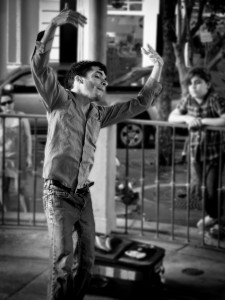 Our first fool. Zarmarus who lived around the time of Christ. Here is his story, as related by Judith Schalansky in her book An Inventory of Losses:
Our first fool. Zarmarus who lived around the time of Christ. Here is his story, as related by Judith Schalansky in her book An Inventory of Losses:  Let’s stick with the Buddhists for now, and one of my favourites, the Zen monk Joshu who was born and lived in Northern China from around 778 to 897 AD.
Let’s stick with the Buddhists for now, and one of my favourites, the Zen monk Joshu who was born and lived in Northern China from around 778 to 897 AD. 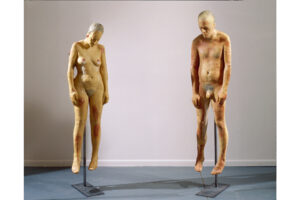
 Whilst preparing this piece on the fool, I get a phonecall one morning from my mother to tell me that my brother has put his back out again. My brother has been struggling with lower back pain for almost a decade now. Every couple of years he’s consigned to bed for a few weeks, but he also spends a lot of time lying on the floor of editing suites (he makes TV programmes), or train stations, or airports, or the rooms of his house unable to stay upright without a great deal of discomfort. I have had my own brushes with lower back pain, but nothing compared to what my brother has gone through.
Whilst preparing this piece on the fool, I get a phonecall one morning from my mother to tell me that my brother has put his back out again. My brother has been struggling with lower back pain for almost a decade now. Every couple of years he’s consigned to bed for a few weeks, but he also spends a lot of time lying on the floor of editing suites (he makes TV programmes), or train stations, or airports, or the rooms of his house unable to stay upright without a great deal of discomfort. I have had my own brushes with lower back pain, but nothing compared to what my brother has gone through.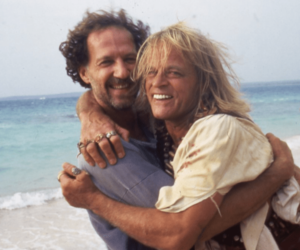 That is to say: the film maker Werner Herzog, and his “muse”, for want of a better word, Klaus Kinski.
That is to say: the film maker Werner Herzog, and his “muse”, for want of a better word, Klaus Kinski. Herzog would also made a documentary about Kinski 18 years after the filming of Fitzcarraldo, and almost a decade after Kinski’s death in 1991. He called his ambivalent tribute
Herzog would also made a documentary about Kinski 18 years after the filming of Fitzcarraldo, and almost a decade after Kinski’s death in 1991. He called his ambivalent tribute 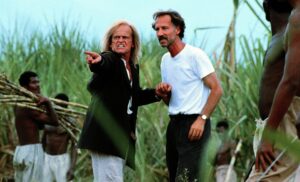
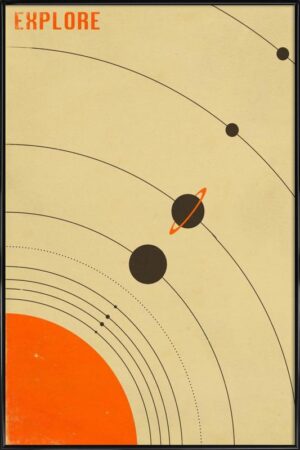
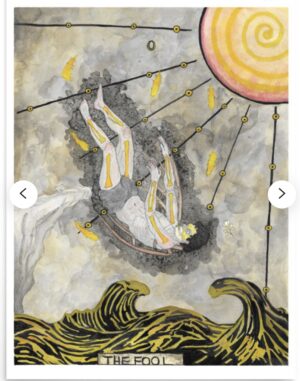 What you might ask has any of this to do with the Tarot fool. Well, at a very simple level: gravity. We are creatures whose minds and bodies work according to gravitational forces. What goes up…scratch must come down. What fades in, must fade out. Or sometimes just stop. In music production, this sudden ending, the equivalent of an orgasm or a heart attack, is called a Cold End. Most classical and early popular music would end in this way (examples). But as soon as we had the technology to create fade-ins and fade-outs, it seems like we often preferred this ending to falling off the edge of a track like that cartoon coyote Wile E. Coyote, the roadrunner’s nemesis, plummeting to their potential death again and again. Listen to how this song which I used in my last episode comes to a cold-ends in its recorded version. And here’s my fade-out on the last chorus, trying to build into that sonic tapering off a sense of us closing the door, but not entirely, on this joyous musical and non-musical tomfoolery which we hope will continue for those involved long after we have exited or left them behind. The fade-out in this case I hope hints at continuity and the perpetuity of life’s riches, even when we are no longer there in body or ears to appreciate this. Perhaps another analogy is that of walking down a gentle, rolling hill after a long hike, walking back into the village where you started from, the body gratified by all it has seen and explored, and looking forward to a pint of Guinness and a packet of peanuts before taking the train home.
What you might ask has any of this to do with the Tarot fool. Well, at a very simple level: gravity. We are creatures whose minds and bodies work according to gravitational forces. What goes up…scratch must come down. What fades in, must fade out. Or sometimes just stop. In music production, this sudden ending, the equivalent of an orgasm or a heart attack, is called a Cold End. Most classical and early popular music would end in this way (examples). But as soon as we had the technology to create fade-ins and fade-outs, it seems like we often preferred this ending to falling off the edge of a track like that cartoon coyote Wile E. Coyote, the roadrunner’s nemesis, plummeting to their potential death again and again. Listen to how this song which I used in my last episode comes to a cold-ends in its recorded version. And here’s my fade-out on the last chorus, trying to build into that sonic tapering off a sense of us closing the door, but not entirely, on this joyous musical and non-musical tomfoolery which we hope will continue for those involved long after we have exited or left them behind. The fade-out in this case I hope hints at continuity and the perpetuity of life’s riches, even when we are no longer there in body or ears to appreciate this. Perhaps another analogy is that of walking down a gentle, rolling hill after a long hike, walking back into the village where you started from, the body gratified by all it has seen and explored, and looking forward to a pint of Guinness and a packet of peanuts before taking the train home. 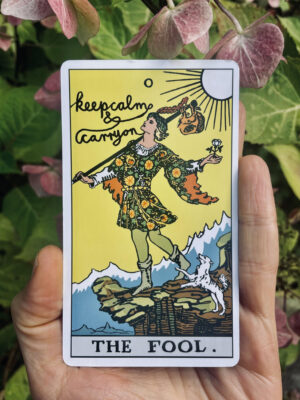 “The person who will not suffer pain fails to ‘suffer’ pleasure” writes the psychoanalyst Wilfred Bion in his book Attention and Interpretation (1970). This denies us, he goes onto explain, the encouragement we might otherwise receive from accidental or intrinsic relief.” We seem inclined at times to cold-end our emotions or perceptions, rather than staying with them for the fade-out, the fall, however that occurs for us.
“The person who will not suffer pain fails to ‘suffer’ pleasure” writes the psychoanalyst Wilfred Bion in his book Attention and Interpretation (1970). This denies us, he goes onto explain, the encouragement we might otherwise receive from accidental or intrinsic relief.” We seem inclined at times to cold-end our emotions or perceptions, rather than staying with them for the fade-out, the fall, however that occurs for us. 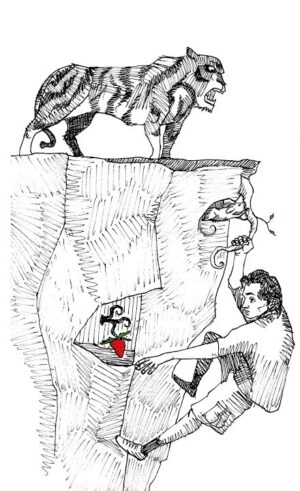 There is a zen parable that I have always loved. It relates to an incident of someone caught between two potential forces of annihilation. Maybe at a more metaphorical level you too might have experienced times when you felt yourself caught between a rock and a hard place, when the thought “Well I’m just screwed here, aren’t I?” confirms some crippling loss of agency for the self. Here is the parable rendered as a pithy poem by Chio Nakamura:
There is a zen parable that I have always loved. It relates to an incident of someone caught between two potential forces of annihilation. Maybe at a more metaphorical level you too might have experienced times when you felt yourself caught between a rock and a hard place, when the thought “Well I’m just screwed here, aren’t I?” confirms some crippling loss of agency for the self. Here is the parable rendered as a pithy poem by Chio Nakamura:  A few months ago however, I saw a Keep Calm & Carry On Tree-shaped air-freshener hanging from the rear-view mirror of a beaten up Rover Mini Cooper and had my own mini awakening. For it struck me that this twofold injunction to self-regulate in moments of high stress (keep calm) plus a behavioural cue to bring one’s focus and energies to a meaningful task (and carry on), was as good an operating system for our current iteration of human animality as anything else.
A few months ago however, I saw a Keep Calm & Carry On Tree-shaped air-freshener hanging from the rear-view mirror of a beaten up Rover Mini Cooper and had my own mini awakening. For it struck me that this twofold injunction to self-regulate in moments of high stress (keep calm) plus a behavioural cue to bring one’s focus and energies to a meaningful task (and carry on), was as good an operating system for our current iteration of human animality as anything else. 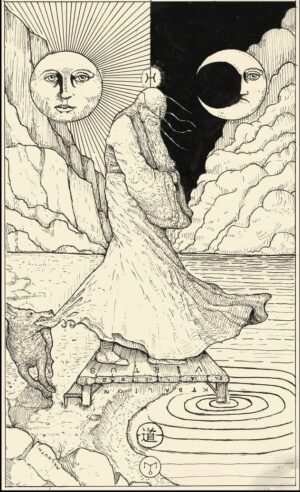 There is a great deal of psychological coherence within these linguistic systems, mapping as they do onto our lived experiences. Having control is also about being up (to be on top of things, at the height of your power, to rank above someone else) whereas being subject to control is down (under someone’s thumb, declining powers, a social inferior). Status in genreal is an up-down game (rising to the top, climbing the ladder, upward mobility) versus being bottom of the social hierarchy. More is up (income rising, productivity increasing) less is down (you’re underage, can;t come in; turn the heat down on the thermostat). Good is up, bad is down. Virtue is up (to have high standards, be an upright citizen) whereas depravity is down (it’s beneath you, to be underhanded, I wouldn’t stoop to that). And this also maps over to the virtue of rationality which is experienced as up versus emotions which are experienced as down (the discussion fell to an emotional level, we say, but we raised it back up to a more level-headed plane; we try to rise above our emotions, keeping things in perspective often involves a sense of hovering over everything that is threatening to pull us down.
There is a great deal of psychological coherence within these linguistic systems, mapping as they do onto our lived experiences. Having control is also about being up (to be on top of things, at the height of your power, to rank above someone else) whereas being subject to control is down (under someone’s thumb, declining powers, a social inferior). Status in genreal is an up-down game (rising to the top, climbing the ladder, upward mobility) versus being bottom of the social hierarchy. More is up (income rising, productivity increasing) less is down (you’re underage, can;t come in; turn the heat down on the thermostat). Good is up, bad is down. Virtue is up (to have high standards, be an upright citizen) whereas depravity is down (it’s beneath you, to be underhanded, I wouldn’t stoop to that). And this also maps over to the virtue of rationality which is experienced as up versus emotions which are experienced as down (the discussion fell to an emotional level, we say, but we raised it back up to a more level-headed plane; we try to rise above our emotions, keeping things in perspective often involves a sense of hovering over everything that is threatening to pull us down. 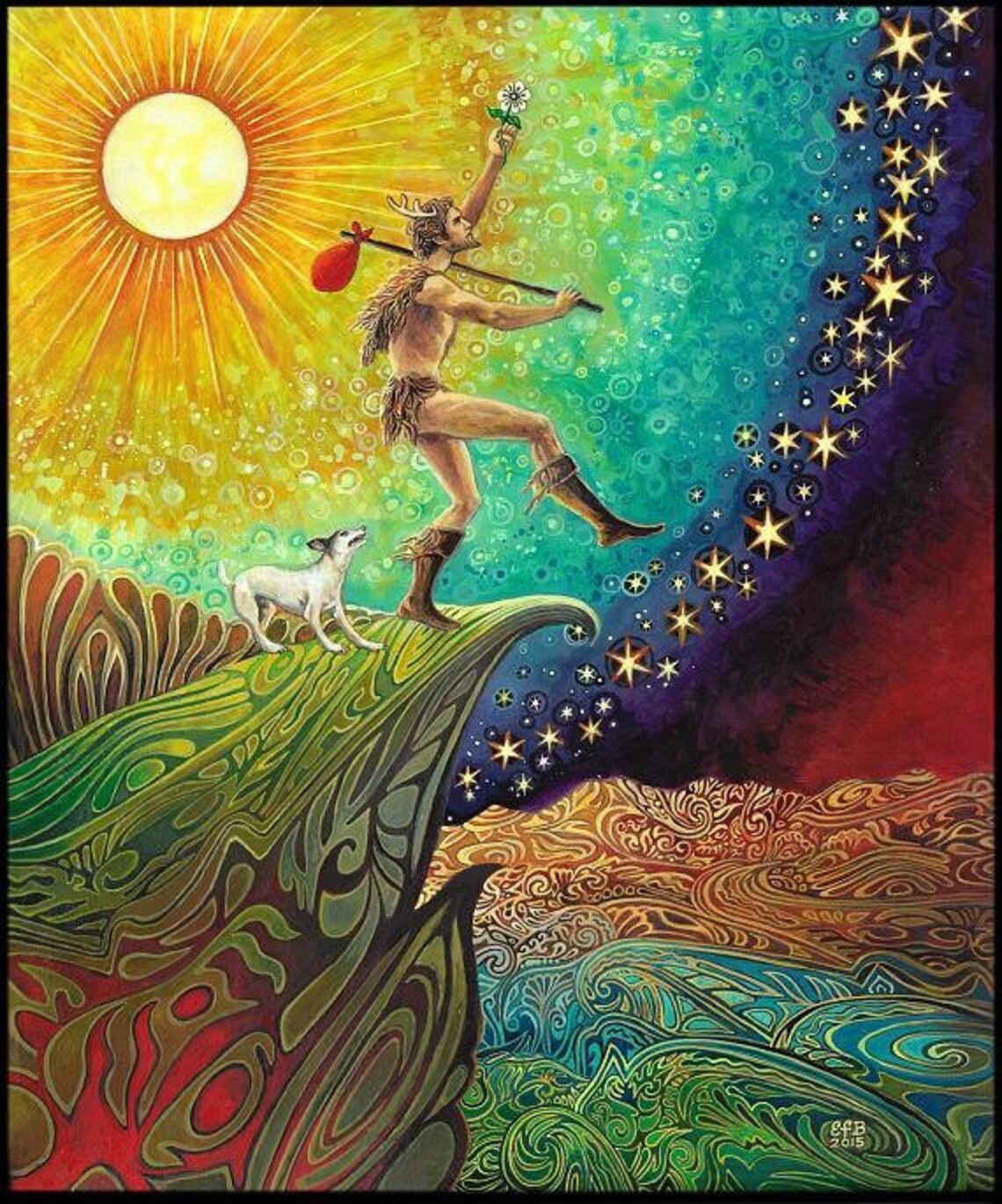

 Everyone else in this painting can be understood as inhabiting a persona: the word taken directly from the Latin by Carl Jung in the early years of the last century, as he grappled with his understanding of the animal human psyche, his own and that of others. It refers, as you may know, to masks worn by “actors in antiquity”. Our persona is how we present to the Outer World as Jung called it: all our interactions with others in the flesh or more likely nowadays, as avatars in the metaverse of social media. There is little felt, inner presence to this experience, we are absent somehow when we inhabit a persona, we fuse with and into its function and force.
Everyone else in this painting can be understood as inhabiting a persona: the word taken directly from the Latin by Carl Jung in the early years of the last century, as he grappled with his understanding of the animal human psyche, his own and that of others. It refers, as you may know, to masks worn by “actors in antiquity”. Our persona is how we present to the Outer World as Jung called it: all our interactions with others in the flesh or more likely nowadays, as avatars in the metaverse of social media. There is little felt, inner presence to this experience, we are absent somehow when we inhabit a persona, we fuse with and into its function and force. 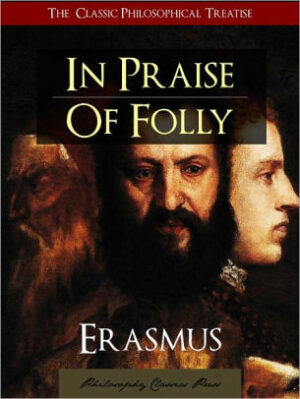 It is here that the young Erasmus wrote his masterpiece In Praise of Folly. I’d never read the book, even though I’d often read of it whilst doing my term of renaissance studies at University. Recently I listened to In Praise of Folly as an audiobook, and I’m glad I did for it comes across, I kid you not, as an early Renaissance Netflix Comedy Special. If you’re a fan of Bill Hicks, or Nish Kumar, Frankie Boyle, Hannah Gadsby, Schumer, Wong, Silverman, anyone with a bit of bite, you will dig In Praise of Folly, although it does at times wear its 15th century misogyny on its sleeve like dried vomit on a denim jacket.
It is here that the young Erasmus wrote his masterpiece In Praise of Folly. I’d never read the book, even though I’d often read of it whilst doing my term of renaissance studies at University. Recently I listened to In Praise of Folly as an audiobook, and I’m glad I did for it comes across, I kid you not, as an early Renaissance Netflix Comedy Special. If you’re a fan of Bill Hicks, or Nish Kumar, Frankie Boyle, Hannah Gadsby, Schumer, Wong, Silverman, anyone with a bit of bite, you will dig In Praise of Folly, although it does at times wear its 15th century misogyny on its sleeve like dried vomit on a denim jacket. 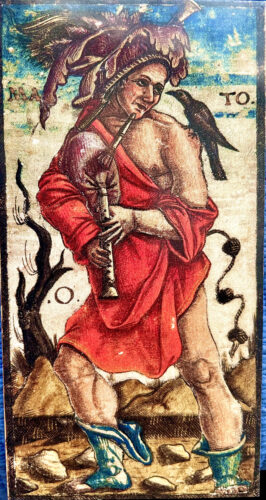
 Ratios (especially that of the golden ratio) controlled musical, physical and mathematical beauty and order. Understanding nature was as simple as understanding the mathematics of proportions. In the Greek universe, earth sat neatly at the centre of the universe, and the sun, moon, planets, and stars revolved around the earth, each pinned inside a sphere. The ratios of the sizes of the spheres were arranged in a comprehensible orderly way. Naturally they were, designed by God, and maybe even were further proof of this God, so as the spheres moved, they made music at different pitches, all together, the moving planets made a “harmony of the spheres,” and so the heavens and our place as human animals as witnesses to this, became beautiful mathematical orchestra which all beautifully added up. “All is number,” wrote Pythagoras, and zero wasn’t a number. Zero was a threat.
Ratios (especially that of the golden ratio) controlled musical, physical and mathematical beauty and order. Understanding nature was as simple as understanding the mathematics of proportions. In the Greek universe, earth sat neatly at the centre of the universe, and the sun, moon, planets, and stars revolved around the earth, each pinned inside a sphere. The ratios of the sizes of the spheres were arranged in a comprehensible orderly way. Naturally they were, designed by God, and maybe even were further proof of this God, so as the spheres moved, they made music at different pitches, all together, the moving planets made a “harmony of the spheres,” and so the heavens and our place as human animals as witnesses to this, became beautiful mathematical orchestra which all beautifully added up. “All is number,” wrote Pythagoras, and zero wasn’t a number. Zero was a threat.